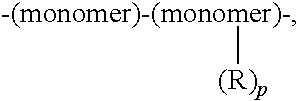Dual Character Polymer Useful in Fabric Care Products
a fabric care and polymer technology, applied in the field of dual function polymers, can solve the problems of hydrophobic stains, different types of soil removal problems, and many surfactant-based products that do not achieve complete removal of greasy/oily stains,
- Summary
- Abstract
- Description
- Claims
- Application Information
AI Technical Summary
Benefits of technology
Problems solved by technology
Method used
Image
Examples
example 1
[0108]In this Example randomly substituted cellulose is synthesized. Six different samples are synthesized using the procedure below. The number average molecular weight and the weight average molecular weight are determined.
[0109]The randomly substituted cellulose is synthesized using the following steps. Into a 2 L beaker with overhead mixer and heating plate distilled water (1200 g) is added and CMC (70.40 g) is mixed in. The sample is heated gently to 45° C. When the reaction temperature is reached 1 N HCl (14 mL) is mixed in to adjust the pH to 4-5. A preheated aqueous solution at ˜50° C. of NaH2PO4 (0.51 g), acetic acid (1 small drop), and cellulose (0.21 g) in water (200.78 g) is added. The solution is mixed well. The extremely viscous solution looses viscosity rapidly. Samples A, B, C, & D are taken at time=10, 20, 30, & 50 minutes respectively. Samples are taken by pouring ˜300 mL of the cellulose mixture into a beaker filled with ˜600 mL of a 70 / 30 volume mixture of ethano...
example 2
[0111]In this Example, several different charged modified cellulose polymers were synthesized. The number average molecular weight and the degree of substitution (DS) are determined. The results are presented in Table 2.
TABLE 2Molecular Weight and Degree of SubstitutionSamplePolymerMWnAnionic DSCationic DSG2-hydroxyethyl cellulose90K—0Hhydroxypropyl cellulose100K —0Icarboxy methyl cellulose,100K 1.20.005Na, withcationic functional groupDS = 0.005Jcarboxy methyl cellulose,50K0.70.01Na, withcationic functional groupDS = 0.01K*2-hydroxyethyl cellulose, 0.750hydrophobiclly modifiedL*methyl cellulose86K—0
example 3
Cleaning Composition Formulation
[0112]Sample formulations are prepared utilizing modified polysaccharides soil release polymer according to one aspect of the present disclosure. The formulations are prepared using standard industry practice to mix the ingredients. Formulations I, II, and III include 1% by weight of the modified polysaccharide soil release polymer whereas Formulation IV includes 3% by weight of the modified polysaccharide soil release polymer. The compositions of the four formulations are set forth in Table 3. The example cleaning composition formulations are examined to establish their ability to promote release of hydrophilic or hydrophobic soil and / or staining materials from a treated fabric surface during a washing process.
TABLE 3Cleaning Composition FormulationsIngredientsFormulation IFormulation IIFormulation IIIFormulation IVSodium16.0000 14.0000 12.0000 7.9alkylbenzenesulfonateSodium alkyl alcohol——— 4.73ethoxylate (3) sulfateSodium mid-cut alkyl1.50001.5000—...
PUM
| Property | Measurement | Unit |
|---|---|---|
| weight average molecular weight | aaaaa | aaaaa |
| weight average molecular weight | aaaaa | aaaaa |
| structure | aaaaa | aaaaa |
Abstract
Description
Claims
Application Information
 Login to View More
Login to View More - R&D
- Intellectual Property
- Life Sciences
- Materials
- Tech Scout
- Unparalleled Data Quality
- Higher Quality Content
- 60% Fewer Hallucinations
Browse by: Latest US Patents, China's latest patents, Technical Efficacy Thesaurus, Application Domain, Technology Topic, Popular Technical Reports.
© 2025 PatSnap. All rights reserved.Legal|Privacy policy|Modern Slavery Act Transparency Statement|Sitemap|About US| Contact US: help@patsnap.com



